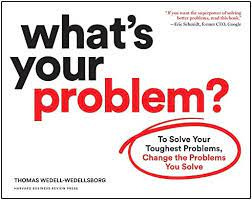Books on defining and framing problems
Good problem definition, framing and articulation is such a rare skill!
One of my biggest observations over the past few months with leaders, founders, and product managers is that most don’t take the time to understand, define and frame the problem correctly. As a result, they end up not being right often, as they pursue the wrong opportunities or make incorrect decisions.
Recognizing, defining, and framing problems is a trained skill. Given the importance of this topic in the business world, I am still amazed at how less it is spoken about.
Here are my recommendations for some books that can help you shape your thinking.
Are your lights on? by Donald C Gause and Gerald M Weinberg.
This book was short but honestly not an easy read. However, you will walk out with some absolute golden nuggets regarding how to look at problems. For instance, problem displacement is a great takeaway for me. As per the book, when you solve one problem, it creates a problem someplace else. So having this awareness is tremendously useful when you navigate your business or product decisions.
What’s your problem? by Thomas Wedell-Wedellsborg
Thomas does provide a simple approach to reframing problems. The approach includes a canvas that has three steps - framing, reframing, and overcoming resistance. I found the approach simple yet effective.
Invisible solutions by Stephen Shapiro
The title is a misnomer, it’s a book about problems and ways to reframe them using 25 different lenses. The author has made a good attempt to provide an exhaustive list of lenses to consider when framing problems.
However, I find this hard to implement unless you have years of practice and deliberately implement this approach in problem-solving. A good read, nonetheless, to carry a couple of lenses handy to help you reframe the problem.Note: I don’t really recommend the next two books unless you have a lot of time.
Problem-solving 101 by Ken Watanabe
This is a book for newbies. Someone early in their career or just out of college could benefit from this. Easy read!
Cracked it by Bernard Garrette, Corey Phelps, and Olivier Sibony
Not a great book, to be honest. It has its parts where it’s good, and somewhere it’s hard to progress as you will find this book all over the place. The initial part of the book provides a framework called TOSCA to define problems. While largely for consultants, this could also help any business leader/product manager as they are thinking through the problems.
Hope you found it helpful. Should you manage a low-frequency product, you can check out my blog on classifying problems published on Reforge.



![Invisible Solutions: 25 Lenses that Reframe and Help Solve Difficult Business Problems by [Stephen Shapiro] Invisible Solutions: 25 Lenses that Reframe and Help Solve Difficult Business Problems by [Stephen Shapiro]](https://substackcdn.com/image/fetch/$s_!A5B2!,w_1456,c_limit,f_auto,q_auto:good,fl_progressive:steep/https%3A%2F%2Fbucketeer-e05bbc84-baa3-437e-9518-adb32be77984.s3.amazonaws.com%2Fpublic%2Fimages%2Fd2b69cc0-1964-48f3-89c4-35ce4cc708ed_335x500.jpeg)
![Problem Solving 101: A simple book for smart people by [Ken Watanabe] Problem Solving 101: A simple book for smart people by [Ken Watanabe]](https://substackcdn.com/image/fetch/$s_!4Zr1!,w_1456,c_limit,f_auto,q_auto:good,fl_progressive:steep/https%3A%2F%2Fbucketeer-e05bbc84-baa3-437e-9518-adb32be77984.s3.amazonaws.com%2Fpublic%2Fimages%2F30ab0c21-2340-4d2a-93eb-480f5838a19c_316x500.jpeg)
![Cracked it!: How to solve big problems and sell solutions like top strategy consultants by [Bernard Garrette, Corey Phelps, Olivier Sibony] Cracked it!: How to solve big problems and sell solutions like top strategy consultants by [Bernard Garrette, Corey Phelps, Olivier Sibony]](https://substackcdn.com/image/fetch/$s_!VK5m!,w_1456,c_limit,f_auto,q_auto:good,fl_progressive:steep/https%3A%2F%2Fbucketeer-e05bbc84-baa3-437e-9518-adb32be77984.s3.amazonaws.com%2Fpublic%2Fimages%2F2af8c79e-0649-4512-9a6e-1b0200e5ada7_330x500.jpeg)